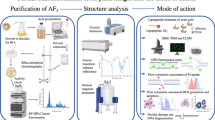Abstract
Studies on the purification of an antitrypanosomal factor (ATF-II) obtained fromPseudomonas fluorescens disclosed that high-pressure liquid chromatography (HPLC) with a Rad-pak μporasil (10 μ silica) column and a GPC-60 Å column was an efficient procedure for the separation of the active components. Extraction of the factor with absolute ethanol prior to elution significantly enhanced the lytic activity of the HPLC eluates, as shown by marked pathologic changes followed by lysis in bioassays performed withTrypanosoma equiperdum. HPLC provided an increase of purification 30 times that obtained with gel filtration of the crude bacterial product. The lipopolysaccharide content of the purified fractions was markedly reduced and indicated an additional advantage for further in vivo tests in experimental infections withT. cruzi.
Similar content being viewed by others
Literature Cited
Berdy J (1974) Recent developments of antibiotic research and classification of antibiotics according to chemical structure. Adv Appl Microbiol 18:309–406
Groupé V, Pugh LW, Weiss D, Kochi M (1951) Observations on antiviral activity of viscosin. Proc Soc Exp Biol Med 78:354–358
Herr RR, Argoudelis AD, Bergy ME, Jahnke HK (1964) Three chemically related metabolites ofStreptomyces. I. Isolation and characterization. Antimicrob Agents Chemother, Proceedings of the Fourth Interscience Conference, pp. 100–104
Hiramoto M, Osaka K, Nagai S (1970) The revised structure of viscosin, a peptide antibiotic. Tetrahedron Lett 13:1087–1090
Hochstein HD, Elin RJ, Cooper JF, Seligman EB Jr, Wolff SM (1973) Further developments ofLimulus amoebocyte lysate test. Bull Parenter Drug Assoc 27:137–148
Kiprianova EA, Smirnov VV (1981)Pseudomonas fluorescens, a new producer of antibiotic substances. Antibiotikii (Moscow) 26:135–143.
Lanham SM, Godfrey DG (1970) Isolation of salivarian trypanosomes from man and other mammals using DEAE-cellulose. Exp Parasitol 28:521–534.
Leisinger T, Margraf R (1979) Secondary metabolites of the fluorescent pseudomonads. Microbiol Rev 43:422–442
Lowry OH, Rosebrough NJ, Farr AL, Randall RJ (1951) Protein measurement with the Folin phenol reagent. J Biol Chem 193:265–275
Mercado TI, Colón-Whitt A (1982) Lysis ofTrypanosoma cruzi byPseudomonas fluorescens. Antimicrob Agents Chemother 22:1051–1057
Mercado TI, Butany JW, Ferrans VJ (1986)Trypanosoma cruzi: ultrastructural changes produced by an anti-trypanosomal factor fromPseudomonas fluorescens. Exp Parasitol 61:65–75
Rastogi SC, Seligman EB Jr, Hochstein HD, Dawson JH, Farag LG, Marquina RE (1979) Statistical procedure for evaluating the sensitivity ofLimulus amoebocyte lysate by using a reference lysate. Appl Environ Micobiol 38:911–915
Umezawa H (1971) Natural and artificial bleomycins: chemistry and antitumor activities. Pure Appl Chem 28:665–680
Von Gräf W, Bickel H (1961) Antibiotische Eigenschaften und Toxizität des Wirkstoffes ausPseudomonas fluorescens. Arch Hyg Bakteriol 145:21–25
Author information
Authors and Affiliations
Rights and permissions
About this article
Cite this article
Mercado, T.I., Strickler, P., Rice, K.C. et al. Purification of an antitrypanosomal factor fromPseudomonas fluorescens by high-pressure liquid chromatography. Current Microbiology 16, 179–183 (1988). https://doi.org/10.1007/BF01568526
Issue Date:
DOI: https://doi.org/10.1007/BF01568526




